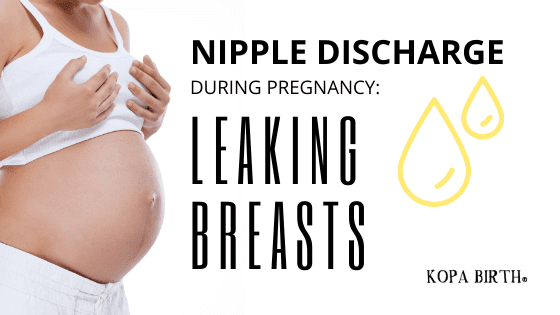
Sure, most of us know that milk may leak from our breasts after the baby is born. But did you expect nipple discharge during pregnancy?! You may wonder if it’s normal and why it happens. Let’s learn more!
Estimated reading time: 5 minutes
Before we discuss nipple discharge, let’s cover what happens to your breasts during pregnancy. From the very start of your pregnancy, with the change of hormones that accompany it, your breasts begin preparing to feed your baby (1, 2). In fact, some women notice breast tenderness as the very first sign of pregnancy. Early on, the alveoli (small sacs inside your breasts where milk is made) begin growing larger and increasing in number. These alveoli are grouped into lobules, and inside your breasts are clusters of lobules (3, 4). From these production and storage sacs, ducts carry milk to the nipple.
While these changes are happening inside your breasts, you may also notice some visible changes. Your breasts will likely grow larger and heavier. Your nipples and areolae (the circle of darker skin around the nipple) may become darker and larger. You may notice little bumps around your nipples. These are called Montgomery’s tubercles, and they produce oil to keep the skin lubricated and to act as a barrier against infection. You may notice that you can see veins under the skin of your breasts, which is a result of the increased volume of blood in your body. And, as we’re about to discuss, you may notice nipple discharge at some point during your pregnancy.
Before your body starts producing the “regular” breast milk that will feed your baby, it produces colostrum, which is the real cause behind nipple discharge during pregnancy (1, 3).
Colostrum is produced from around the middle of your pregnancy until your baby is a few days old. It may be thick and yellowish in color, though clear and white is also normal. This fluid may be thought of as a highly nutritious superfood that nourishes your baby with proteins and antibodies, kick-starts her immune system, encourages the passage of meconium, and more.
The simple answer is that your breasts fill with liquid during pregnancy, and sometimes that liquid makes it way out. It may happen when your breasts are squeezed or massaged, stimulated through sex, or may happen simply because there is an increasing amount of internal pressure as your breasts begin to store colostrum.
Some women don’t experience any nipple discharge during pregnancy. For those who do, it may start during the second trimester, though it’s most common at the end of the third trimester (1). In late pregnancy, your body is ready to feed your baby at any time–it is fully prepared to nourish your baby even if born premature. So it is natural that some of that waiting colostrum could make its way out as nipple discharge. Don’t worry if you make it through your pregnancy without noticing any leaking from your breasts, though. No nipple discharge is normal, too.
Most pregnant women don’t experience discomfort with nipple discharge, other than the possibility of feeling a little damp. While you can’t prevent leaking, you can treat discharge in pregnancy the same way you handle leaking breast milk after your baby is born. Simply use breast pads to absorb any fluid, and change them often enough to stay dry and comfortable. Breast pads are just circular pads, either disposable or washable, that go inside your bra. You can buy them almost anywhere baby or nursing supplies are sold.
Just as you can get a clogged duct during breastfeeding, clogged ducts can also happen during pregnancy. As the name implies, this happens when one of the ducts that carry milk out through your nipples becomes clogged or blocked. You may notice a hard lump that is red and/or painful to touch (1, 5). The sensation may feel similar to a painful pimple, which is also caused by a clogged gland. You can usually clear a clog by applying a warm compress or running warm water on it in the shower and gently massaging the area.
Still, if you are concerned about any new lumps or irregularities, or worried that you’re experiencing discharge that isn’t normal, definitely mention it to your doctor or midwife at your next appointment. They can preform a comprehensive exam and help you know if what you’re experiencing is normal or not.
Kopa Birth’s online birthing classes allow you to prepare for a natural hospital birth from the comfort of your own home, 24/7. Enroll today in our free online childbirth class and start preparing for your natural birth!
References:
Sure, most of us know that milk may leak from our breasts after the baby is born. But did you expect nipple discharge during pregnancy?! You may wonder if it’s